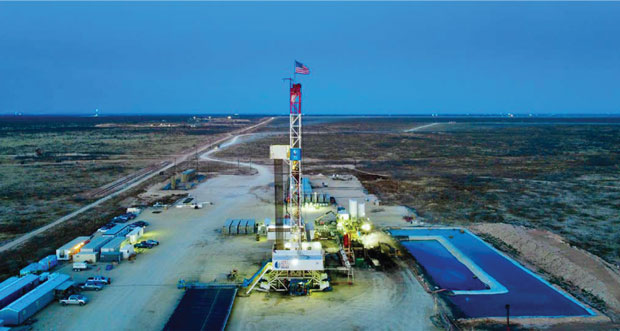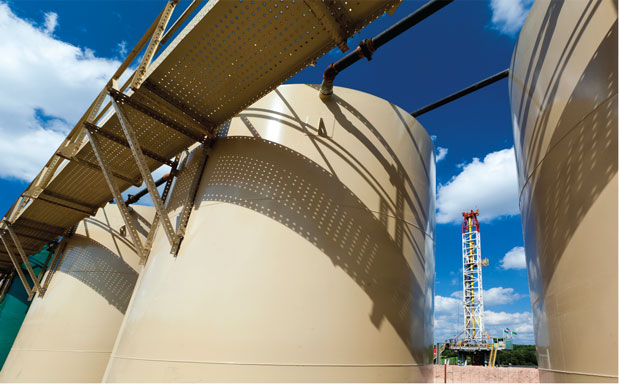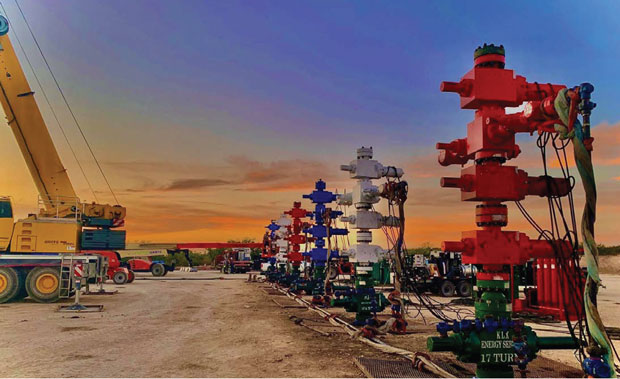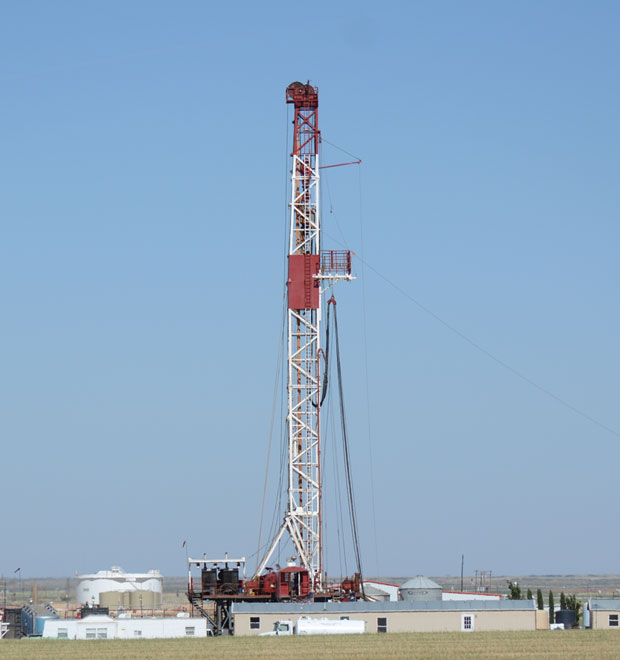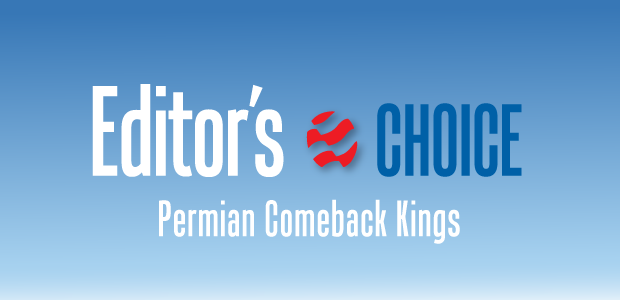
Operators Ramping Drilling, Eyeing Acquisition Targets In Red-Hot Tight Oil Plays
By Danny Boyd, Special Correspondent
HOUSTON–One short decade ago, the Permian Basin was producing less than 1 million barrels of oil and 5 billion cubic feet of natural gas a day. In June, daily output is forecast to hit all-time records of more than 5 MMbbl/d of oil and 20 Bcf/d of gas, according to U.S. Energy Information Administration models.
If those projections hold true, it means daily production will have jumped by 260,000 barrels of oil and nearly 500 MMcf over the first six months of 2022. In other words, the “amazing basin” added some 1,445 barrels of oil and 2.8 Mcf of gas every 24 hours on average!
Simply incredible.
But while production is trending sharply higher, consider another eye-grabbing statistic from EIA: The number of drilled but uncompleted wells has fallen each consecutive month for going on two full years. By the end of April, the inventory of drilled but uncompleted wells in U.S. shale basins had dwindled to 4,223–the lowest level since EIA began tracking the data in 2013.
To put that into perspective, the total DUCs in all shale basins in April was only a little more than the number of DUCs in the Permian alone in April 2019. As May began, EIA counted 1,256 DUCs in the Permian–down more than 50% from the same time last year and down 70% from three years prior.
How many of those remaining wells are completable is open to debate, but it’s crystal clear that production growth increasingly is coming from the drill bit. And that suits operators in the basin just fine.
Buttressed by consistently higher oil and gas prices and a veritable wonderland of reserves capture opportunities, the Permian’s vast upside potential is opening plenty of running room for both public and private players.
The majors are raising budgets and large independents are adding acreage, but the small-cap players and private companies continue to lead the drilling charge. As they ramp drilling programs, they are expanding acreage positions and seeking ways to do creative deals that let new and proven investors alike in on the action.
Gaining Scale
After adding assets and growing production by more than 400% since 2020, Earthstone Energy Inc. continues to search for attractive acquisition targets and take advantage of tried-and-true techniques to make the most of assets in the northern Delaware Basin and southern Midland Basin, says Chief Executive Officer Robert Anderson.
On board with Executive Chairman Frank A. Lodzinski and others since a 2014 reverse merger with Oak Valley Resources LLC, Anderson explains that The Woodlands, Tx.-based public company entered the Midland Basin with acquisitions in 2016-17 and continued to search for ways to gain scale in the Permian and appeal to more investors.
At the beginning of 2020, a well-hedged Earthstone anticipated achieving positive free cash flow early in the year, but instead shelved capital spending, paid down debt, and focused on finding acquisition targets as oil prices fell below zero during the bleakest days of the covid-induced downturn. The search for new additions has paid off.
The company’s purchase of Independence Resource Management, resulting in an 18% stock price hike in one day in late 2020, kick-started a largely equity-backed growth spurt that includes four acquisitions and two bolt-ons thus far, with Earthstone optimistic of more ahead as it focuses on integration and execution of its acquired assets, Anderson says.
After closing on a string of acquisition deals that has helped it grow production four-fold since 2020, Earthstone Energy continues to search for assets that can help it keep expanding its operational scale in the northern Delaware and southern Midland basins.
“We are a very healthy company with a great leverage profile and great cash flows and we are not done yet,” he says. “I think there is the ability for us to do more deals, and the sellers that have taken Earthstone’s stock are pleased with the performance.”
A 2022 capital budget of $410 million-$440 million assumes a four-rig program, two in each basin, to spud an estimated 60 gross operated wells with first-production anticipated from about 58. About 20 nonoperated wells are expected to be drilled and completed, Anderson says. Second quarter guidance pegs overall equivalent production at 70,000-74,000 barrels of oil equivalent a day, up from 15,000 boe/d in 2020.
Earthstone’s first foray in the Delaware Basin came with the purchase of Chisholm Energy Partners LLC in February. That deal included 13,500 boe/d (79% liquids) on 35,100 net acres in the core of the northern Delaware in Eddy and Lea counties, N.M.
In April, the company brought on line the two-well Minis pad, targeting the 3rd Bone Spring Harkey Sand, with production over the first 24 days of 1,600 boe/d (87% oil) from 7,500-foot laterals. In May, rigs were drilling in Earthstone’s Ram project, including 10,000-foot laterals on a two-well pad in Lea County, and a two-well pad in the company’s Cletus project area in Eddy County.
Also in April, Earthstone closed on its acquisition of Bighorn Permian Resources LLC in the southern Midland Basin, which included 35 net drilling locations on conservative spacing. The assets are largely a cash flow engine, Anderson explains, with production of 42,400 boe/d, including 25% oil and 57% liquids, on 110,600 net acres mostly in Texas’ Reagan and Irion counties near Earthstone’s legacy assets.
In the Midland Basin, one rig in May was drilling an average 9,900-foot laterals on a five-well pad at Earthstone’s Barnhart project area in Irion County and the other 14,300-foot average laterals on a four-well project in its TSRH area in Reagan County, he points out.
Stage spacing in the Midland Basin is typically shorter, but otherwise completion designs in the two sub-basins are similar, Anderson notes, with 2,000-2,200 pounds of sand pumped per lateral foot, although proppant is lowered to around 1,800 pounds in areas with greater well density.
Earthstone is methodically deploying technology to establish the best well economics, he says. To set up drilling in both basins, the company predrills for surface casing to save days on location. In the Delaware Basin, the company is using 3-D seismic to identify any geological variabilities in order to optimize steering and landing zones.
The company is exploring the advantages of wider spacing compared with industry offsets as it works to avoid overdevelopment, higher costs and lower yields, Anderson says.
Exceeding Expectations
Running four rigs in the Delaware Basin, Oklahoma City-based Continental Resources Inc. is focusing on the Bone Spring and Wolfcamp intervals across its position, relying on its historically strong petrotechnical and operating know-how to produce better-than-expected productivity, capital efficiency and resource potential, says Doug Lawler, chief operating officer.
Exceptional team skills based on years of detailed, focused technical evaluation prior to entering new basins, and having advanced understanding of numerous stacked reservoirs, is making a difference for Continental in the Delaware Basin, he insists. The first quarter of 2022 included stellar Permian highlights.
“We are excited about the initial results from a recently completed 10-well unit that is meeting and/or exceeding our expectations, flowing cumulative 15,300 boe/d from 10 wells targeting 3rd Bone Spring and Wolfcamp A reservoirs,” Lawler says.
Adding to the excitement are expectations generated by the successes in other areas, particularly to the north, that can be developed fully within the next few years and that are expected to generate serious volumes for the company, he told investors in May.
After entering the Delaware Basin in December through a $3.25 billion deal with Pioneer Natural Resources, Continental Resources is running four rigs on its 170,00 acre position. It followed the Permian purchase with a strategic acquisition in the Powder River, where it is running two rigs on 390,000 acres. In the Bakken and SCOOP/STACK–where Continental reigns as top producer and controls a combined 1.275 million acres–it is running six and eight rigs, respectively.
The company, which last considered a Permian position around the turn of the century, added its Delaware acreage in December from Pioneer Natural Resources in a $3.25 billion cash transaction for acreage, production and infrastructure in Texas’ Ward, Reeves, Pecos and Winkler counties.
Proved developed producing reserves represented 75% of the transaction price, with 55,000 boe/d being 70% oil. Continental also recently added bolt-on acreage in Ward and Winkler counties.
The Pioneer transaction included 92,000 contiguous net leasehold acres–98% operated with more than 90% held by production–50,000 net royalty acres and 31,000 net surface acres. Annual cash flow of $750 million was expected from operations, including $500 million of annual free cash flow this year based on last fall’s price decks. The addition is part of more than 600,000 net acres added to Continental’s overall portfolio over the past 18 months.
The Delaware position includes 180 miles of water pipeline and ample water disposal capacity, 650-plus gross operated locations in the 3rd Bone Spring/Wolfcamp A and B, and more than 1,000 total locations, including additional zones producing in the basin. The Bone Spring and Wolfcamp targets include eight pays altogether.
“We will continue to look at these opportunities that make strong economic sense and provide the opportunity for future investment that is competitive within our portfolio,” Lawler relates, noting that the average acquisition price has been less than $10,000 an acre.
Workovers also are a powerful story. The company is looking at workover targets companywide, including in the Delaware Basin, Lawler reports.
“Everything we have seen so far we have really liked, coming in equal to or better than what our expectations were,” Chief Executive Officer Bill Berry stated during the company’s first quarter earnings call in early May.
Bolt-ons will continue to be the preferred method of adding acreage, Berry says, given current prices producing a more difficult bid-ask spread.
Although players across the basin are seeing the same gas offtake issue, more takeaway capacity is on its way and Continental is developing at a pace commensurate with its expectations of what that will be, Berry adds.
Growth Opportunities
Based in Arlington, Tx., U.S. Energy Development Corporation continues to eye Permian growth opportunities as it builds on operating and nonoperating interests in the Delaware Basin, says Chief Executive Officer Jordan Jayson.
The company intends to deploy upward of $200 million-$300 million over the next 12-18 months in the Permian. That includes up to 12 new operated wells, which may grow if it can acquire more operated acreage, and participation in 36-50 nonoperated wells, Jayson says. In May, the company was drilling a three-well pad tapping into the Wolfcamp A in Ward County.
“We have been very successful in the Delaware as an operator and as a non-operator over the past 36 months and we continue to search for acquisitions and different opportunities to partner with operators and mineral owners to develop acreage positions,” he says.
U.S. Energy Development Corporation plans to invest $200 million-$300 million over the next 12-18 months in the Permian Basin to drill and complete up to a dozen operated wells–a number that could grow if it acquires more operated acreage–and participate in up to 50 nonoperated wells.
While there is limited available acreage in the core of the western sub-basin, opportunities do exist, he comments. U.S. Energy Development works to be creative in finding joint venture deals, he points out, but partners are harder to come by, although he says the demand to participate in new projects is as high as he has seen in 13 years.
“There is no doubt that at $110 oil, most groups do not need partners and that is the big difference from 2020 and even parts of 2021,” Jayson explains. “Finding venture partners has gotten more challenging, but we have still been successful in executing. We simply have to push ourselves even harder to find those potential partners, and hopefully, come to terms to execute a successful joint venture.”
Currently, more PDP is coming on the market in the Permian, and PDP transactions will accelerate if prices remain high, he predicts. Even with the surge in offerings, expectations are being managed well by sellers, investment banks and advisers, and buyers are focused on strip prices and due diligence.
“When we are considering a position, we look at making sure we are not missing something from a marketing, transportation or lease operating expense standpoint,” Jayson says. “There is a lot of focus on our team making sure if we are going to buy something at today’s strip that we are not going to get hurt somewhere else in the deal.”
For the company, the vast majority of operating and nonoperating interests acquired over the past 36 months have been in Lea and Eddy counties in New Mexico and Loving, Reeves and Ward counties in Texas, he says.
Current development includes, where available, longer laterals, with some operating partners proposing three-mile horizontals, Jayson reports.
As a nonoperator, U.S. Energy Development has participated in more than 100 Delaware Basin wells in the past three years, he says. As far as assessing investing opportunities as a nonoperator, the primary focus in financial terms is wellbore control, Jayson emphasizes.
“Those are the first three things that we focus on because with the type of assets we are looking at, it is about preservation of capital with upside,” he remarks. “We are not searching for ways to hit home runs. We are looking to hit singles and be consistent. I think we are prudent in the deals we are evaluating. Our team of engineers has done a great job of evaluating different operators historically.”
Conventional Workhorse
With a net position of 64,380 acres, Ring Energy has generated positive cash flow for 10 quarters applying unconventional drilling and completion techniques to the conventional Permian workhorse that accounts for 40% of 30 billion barrels in historic production: the San Andres.
This year, the public company plans to drill 30-33 wells, including nine-ten on the Central Basin Platform and the remainder in the Northwest Shelf, says Chairman and Chief Executive Officer Paul McKinney. Drilling and completions costs range from $2.8 million to $3.8 million on relatively shallow wells at ±5,000 foot depths, he says.
Ring Energy plans to invest $130 million in capital this year to drill 30-33 San Andres horizontal wells on the Central Basin Platform and Northwest Shelf. Year-over-year production growth is anticipated to range from 6% on the low end to double digits on the high end.
The Woodlands, Tx.-based company is using extensive geoscience and engineering investigation to identity prospects on the edge of conventional plays in areas deemed uneconomical early on, given the limits of conventional development technologies at the time, McKinney explains. The application of these newly developed technologies is paying off as Ring lands laterals in 200-300 foot oil columns and initial per-well oil production ranges from 300 to 700 bbl/d.
“Everybody in the last 15 years has learned to drill horizontal wells and apply multistage frac technologies to unconventional reservoirs, but we are applying these technologies developed for unconventional reservoirs to conventional reservoirs,” McKinney details. “We are drilling horizontal wells in what was believed to be ‘less economic’ rock in which porosity and permeability are less than most conventional rock, but you have to consider this is still a conventional reservoir and the porosities and permeabilities are still considerably higher than in shales.”
On the shelf, development is centered Yoakum County, Tx., but includes properties in adjacent Lea County, N.M., he says. Ring is developing Central Basin Platform acreage in Gaines and Andrews counties in Texas. Companywide production of just under 9,000 boe/d is 85% oil across the structures.
McKinney and his team came aboard in late 2020, and decided that a large amount of legacy acreage could not be allowed to expire without testing different landing zones and completion techniques. For its 2022 drilling program, Ring decided to drill its first four wells in the CBP, all of which came in within expectations, and with one having an IP in excess of 500 barrels of oil a day, McKinney notes.
Although reservoirs across the shelf and platform lack the ubiquitous spread of stacked pays in the Midland and Delaware basins, their initial producing and terminal declines are much shallower and well drilling and completion costs are considerably lower, “allowing the economics to be equal or even superior to many of the shale plays,” he says.
The company plans to spend $130 million in capital this year with only 40% of planned oil production hedged and the remaining oil and natural gas volumes fully exposed to market prices. Production growth could range from 6% to double digits, he predicts.
The company is actively marketing just over 18,000 net acres in the shallow Delaware Basin considered noncore, McKinney says. The position has produced water, gas gathering and pipeline infrastructure, a long-life and shallow decline PDP base, and 98% working interest, he notes.
U-Lateral Designs
PDC Energy Inc. says its deployment of “U-laterals” (two-mile equivalent extended-reach laterals in one-mile sections) is expected to continue to bolster output in the Delaware Basin.
The Denver-based company, fresh off the closing of its acquisition of Great Western Petroleum LLC to expand its sizable Wattenberg position in Colorado, is deploying new well designs and completion practices in the Permian as it spends a budgeted $175 million drilling 16 wells and completing 20 this year, says David Lillo, senior vice president of operations.
In the Delaware Basin, PDC continues to be encouraged with its 2022 turn-in-line program as results from relaxed spacing outperform expectations, Lillo said during the company’s first-quarter earnings call in early May.
For instance, on the Old Monarch pad in Reeves County, the company turned in line three U-laterals and three standard-reach laterals (SRLs). With approximately three months of production history, the U-laterals are trending at or above a 1.5 million boe estimated ultimate recovery while the SRLs are trending to a 700,000 boe EUR, according to 2022 guidance released in late May.
The wells were drilled on eight-ten well per-section equivalent spacing in the Wolfcamp A and B, where a U-lateral utilizes two lateral spaces. The company expects to add additional U-shaped lateral locations to its inventory where appropriate, Lillo says. The company also was testing a 2nd Bone Spring well, which was in the initial phase of flowback in early May.
“We are proud of the team’s use of technology to drill these types of wells,” Lillo remarks. “So far, the initial results are right on expectations, and we continue to look for other ways on our acreage to apply this technology to organically expand our inventory.”
PDC continues to consider potential acreage trades and small bolt-on acquisitions to consolidate and build on its position, he says.
The company produced a steady 28,000 boe/d in the Delaware in the first quarter, but expects a ramp up in output as new wells are turned on line, Lillos says. Throughout the company’s development work, its Delaware team continues to produce at the high end of expectations with improvement also stemming from workover and an electric submersible pump installation program, he details.
“That, and higher-than-expected chemical prices drove LOE to a higher-than-expected level, but the revenue at the increased production at these prices is very economic,” Lillo comments.
In the Delaware Basin and elsewhere, the company continues to improve environmental, social and governance performance. The company plans to reduce GHG and methane emissions by 60% and 50%, respectively, by 2025, from 2020 baseline levels and on a per unit of production basis. In total, more than 25% of the company’s short-term incentive program is tied to ESG and EHS initiatives.
For other great articles about exploration, drilling, completions and production, subscribe to The American Oil & Gas Reporter and bookmark www.aogr.com.







